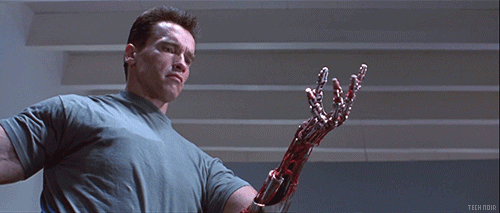8 Times Terminator Made Us Fear the Robot Apocalypse
The series introduced audiences to a new kind of technoparanoia.

Before The Matrix turned the human race into a renewable energy source and Ex Machina plumbed the depths of the uncanny valley, James Cameron’s Terminator painted a horrifying picture of our robot-powered future. Between SkyNet tanks treading on human skulls, Arnold Schwarzenegger’s T-800 brutally murdering an entire station full of cops, and Robert Patrick’s creepy (and stabby) liquid metal T-1000, the Terminator saga has given a face to humanity’s anxiety over artificial intelligence more than perhaps any other franchise (with the exception, perhaps, of 2001’s droll, murderous HAL).
With the imminent release of Terminator: Genysis, we now celebrate the murderous power (and cinematic glory) of our robot overlords:
They look just like us.
Apart from flashbacks (or flashforwards?) to the world’s post-Judgment Day dystopian future, we don’t actually see the skeletal Terminator for what it is until the end of James Cameron’s first film. But the sequence where Arnold removes his weak human flesh from obscuring his robotic vision is both gruesome and horrifying—and, in retrospect, near iconic.
They follow you everywhere.
While the original Terminator won praise for its innovative storyline, Terminator 2: Judgment Day blew audiences away with its eye-popping special effects. Robert Patrick’s advanced T-1000, a departure from the super-jacked juggernaut of Arnold Schwarzenegger’s classic T-800, scared the crap out of unsuspecting audiences with its serial-killer deadpan and vast array of stabbing weapons. Just look at this relentless liquid metal bastard:
Sidenote: The below scene scared the living shit out of me as a child.
They’re efficiently murderous.
This scene, where the T-1000 murders John Connor’s foster parents is particularly gruesome.
They know how to make an terrifying entrance.
There’s a great moment in T2 where Arnold slices off his fleshy human arm to reveal the product of Cyberdyne Systems chief Miles Dyson’s (Joe Morton) cybernetic research. This, too, is quite gross, but also incredibly powerful; we can see the fear in Dyson’s eyes.

They run on fucking hydrogen.
Terminator 3: Rise of the Machines is the weakest film in the franchise, bogged down by a lackluster performance by Nick Stahl as John Connor and a strange emphasis on campy, hokey laughs (“talk to the hand,” really?) instead of the tried-and-true robot anxiety. But Stahl and Schwarzenegger’s flight across desert reveals a new alarming element of the Terminator: They run on sweet, sweet volatile hydrogen fuel cells. Not only do these things have a half life of, well, forever, but they also explode when shaken, making these terrifying skeletons nuclear terrifying skeletons.
They are enormous.
Terminator: Salvation took things in a different direction: Instead of of relying on the infinite regress of time-travel, we finally got to see the post-apocalyptic future that Arnold’s constantly rambling on about. Apart from the perfunctory tank-rolling-over-human skulls and constant threat of hunter-killer drones, Salvation introduced us to a new threat: Giant “harvester” Terminators, who collect human slaves for God knows what. Sometimes, size matters.
There are robot snakes. Robot fucking snakes.
Apart from the harvesters, Salvation also gave us hydrobots, eel-like robot water-snakes designed to patrol rivers. They are vicious, terrifying, and surprising as hell.
They’re just like us, only awkward.
The point of Arnold’s iconic Terminator is that it looks and acts human. Equipped with a fleshy camouflage, the Terminators infiltrate Resistance bunkers in the future and crack heads in the past without causing too much of a general ruckus. But if there’s anything that Arnold’s Big Brother routine with Edward Furlong’s 10-year-old Connor in Terminator 2 taught us, it’s that Terminators are terrible at actually imitating humans. While Linda Hamilton’s Sarah Connor opines that the Terminator’s a better father to John than any of the shlubs she’s shacked up with in the past, the Terminator’s weird affection for John conveys the central theme of the entire franchise: Robots may destroy humans, but they’ll never replace them.
Photos by Paramount Pictures
